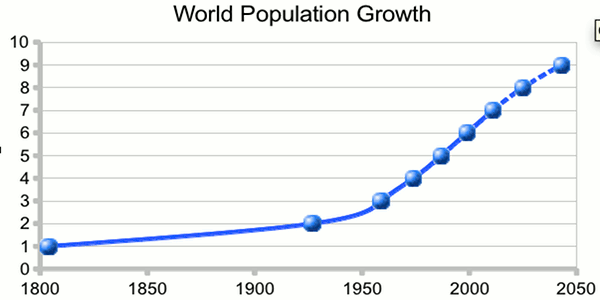As I write this, the world’s 7 billionth person is about to be born. The world’s population is growing fast, though (thankfully) not quite as fast as it was a decade or so ago. This graph challenges us all.

Some statistics
Poverty
Thirty years ago, about 1.9 billion, or 40% of the world’s population lived in extreme poverty, whereas now the figure is down to 1.4 billion. However the effects of population growth and climate change will place great pressure on the world’s food and water resources, and the poor are obviously the ones most likely to suffer.
Aspirations
There is also growth in the aspirations of many, who see the affluence of the west and want to emulate it – and are beginning to do so. For example, there is increasing demand for cars – 20 thousand in 1900, 800 million in 2002 and an estimated 2 billion in 2030. And the oil is running out! This increase in the material standard of living will place additional strain on our planet – most western countries are already using far more than our share of the world’s resources.
Longer lives
There are many signs of improvement in living conditions around the world over the past century. In the past 60 years, average life expectancy has increased from 48 to 68 years, while infant mortality has decresed from 133 per 1000 births to 46. But it will be a challenge to continue this progress.
Youth and age
Population growth changes demographics. Fast growth means a young population, many children, and challenges to feed, care for and educate them. Slowing growth down too fast (as in China) can lead to an aging population and fewer working people to care for them.
Africa
Africa faces incredible problems, with population predicted to more than treble this century while water and food is under threat from climate change.
Facing the challenges
It is likely that you who read this live in the affluent western world. You and I have a standard of living that is probably higher than the world can sustain. If the poor are to be fed and educated, and given an opportunity to climb out of poverty, we are going to have to help, either individually, or via the governments we elect. We may have to be prepared to give up some of our affluence.
Over the next few weeks I will explore some things we can do to make a start.
I find this very pressing global issue such an interesting and perplexing one.
I agree that family planning through education and empowering women to make choices about their bodies and how/when/if they’d like to have children is necessary. They have found that teaching family planning techniques (many of which are natural, therefore “free” and do not require medical treatment) are enormously helpful to women in developing nations. I am more mystified over those who would like to see 1-child policies implemented worldwide as they were in China. Is it morally right to legalise a couple’s ability to have children? and what of the consequences? abortions, adoptions, infanticide that might occur as a consequence of individuals not being able to “comply”.
There’s a deeply moving and starling documentary called “A Woman’s Womb” about the forced/coerced sterilisation of poor rural women in Peru in the Government’s attempts to appease the UN and USAID over their rapid population growth. About 300,000 women were sterilised between 1995-2000, many of whom did not understand what was being done or them or that it couldn’t be reversed. I guess this is a look at the sad extremes of the “population control agenda” – where human rights are overshadowed by “numbers” and “deadlines”. Sadly the health ramifications and social and familial consequences remain lifelong for those women.
(I can send you a link for the film, its free to watch online, if you’re interested)
[…] 7 billion and counting I raised concerns about world poverty in the light of the world’s population reaching 7 […]
[…] short time ago, I posted on poverty and the growing world population (7 billion and counting), and about the challenge of deciding how to respond (The cost of addressing world […]